Japan: a wonderful experience, #1
Posted on June 23, 2023
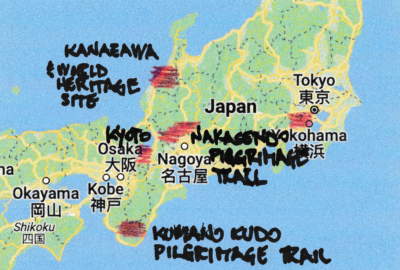
Patti and I have been back three weeks now, and we reflect on what a wonderful experience we had in Japan. It was very different from here. I describe some of the visual, physical differences that I will not forget.
Terrain. Mountains, mountains, mountains. Only 30% of the land is habitable. Japan was formed by tectonic plates slipping underneath another one: volcanos and uplift. The hills are about the steepest I’ve ever seen. It’s like someone took huge sharp shears to cut out the mountain sides. The tops are pointed. Some were so steep, I had a hard time thinking that trees could grow on them. The valleys are narrow. The rivers are pristine. We saw no plains for waving fields of wheat or other crops. Only very small man-made plots to grow rice.

Earthquakes. Japan averages 4 tremors or earthquakes per day. One woke us up the first night we were in Tokyo – pretty violently shaking our bed. That’s the first one we’ve ever experienced.
No really old houses. Volcanic rock – basalt – is so hard that it was not mined or cut into stones for buildings. All old buildings were made of wood. Most all old wooden buildings we saw are reconstructions of buildings that were destroyed by fire. Each has the traditional small open fire for cooking with no stone chimney. The exterior walls of historical homes were a sheet of paper – a thicker, tougher paper than what we have – and NO insulation from the cold.

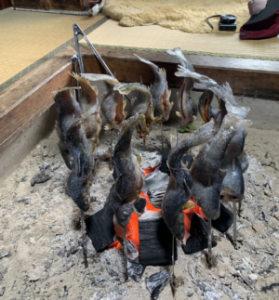
Population density! 38 million live in Tokyo metro area. That’s about equal to PA, OH and IL combined (5th, 6th, and 7th largest states). 19 million live in the Osaka metro area. It is very dense during rush hour. Very few women are on the streets or subways. Almost all men going to work wore black suits and white shirt; a man in a nice grey sport coat and light blue shirt stood out. Everyone is Japanese. This is a very homogenous population with strict requirements for immigrants: a big virtual wall. Foreign-born workers: 3% in Japan vs. about 18% of in the US. I would think economic growth would be limited by lack of workers. NO (or almost no) obesity: about 3% in Japan vs. about a third in the US.
Incredible infrastructure. The US spends 3.5% of its GDP on military expenditures. Japan spends 1.1%. Much of the difference is poured into infrastructure. The subways and trains are spotless and run perfectly on time. The bullet trains are especially nice.
You get a reserved car and seat on a train. The platform has a marking for your car number, and the train precisely hits the mark for you to get on your car. In the cities, you have a barrier with entrance gates that open when it’s time to board the subway or train – a safety precaution so no one falls on the tracks. Workers keep those barriers spotlessly clean.
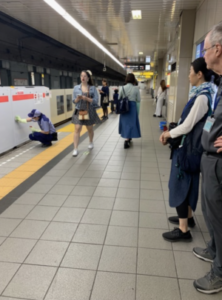
We had to change from a regular train to a bullet train near Nagano that would take us to Osaka. The train we were to get on pulled in from the east, but it would have to go out the same tracks to then head south. While we were waiting to get on, the seats swiveled 180o so that they would face forward in the new direction.
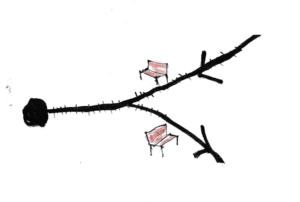
The roads are in perfect repair. Manhole covers are works of art.
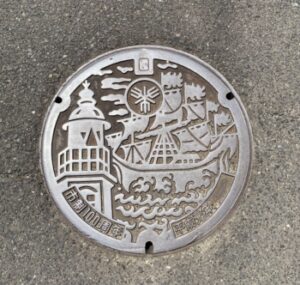
There is NO Litter. There are NO splotches of chewing gum ground into the sidewalks. Our sidewalks in the two shopping areas within walking distance of us look filthy to me, and we likely have 1/20th the foot traffic of Tokyo. The coffee shop I go to is not clean by Japanese standards; I wonder if anyone else notices.
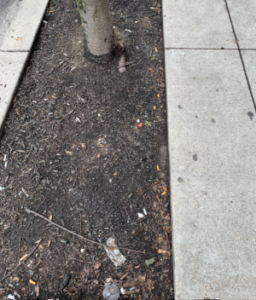
Many public toilets are architectural gems with very clean toilets. I don’t think I’ve even seen a public toilet in a city in the US. I think every toilet seat in Japan has a heated Toto washlet. We’ll buy at least one of those!
Conclusion: Patti and I look forward to our travel experiences. We had a wonderful experience in Japan last month. I describe some of the visual, physical differences that I’ll never forget.
Thanks Tom. I am so glad that Japan has not changed since I was there in 2005. I was equally impressed by the cleanliness and the pride that even the street cleaners took in their work. Are there still women hand sweeping streets in some areas. If you did any shopping, you probably noticed the care that is taken with even the smallest purchase. I’m so glad that you and Patti had such a great time!
My wife and I were lucky to have lived in Japan for nearly seven years while I was in the USAF. We lived near Tokyo and loved the city but really enjoyed the wonderful hiking in the mountains. Of course, the people were unfailingly friendly and loved talking to Americans. My wife never got used to the food which is very different from ours, but I developed a great love for sushi which I still enjoy regularly. Best of all, we were able to adopt one of our beautiful daughters from Osaka!
Professor Nestegg (Tom) should be a travel writer. It’s so refreshing to read interesting observations about “real life” as opposed to the typical hype about hotels and tourist traps. No surprise, as Tom looks at the world like I do. I enjoyed learning about the reason for limited construction materials as well as hillside slope severity, worker attire and gender, super potties, and reserved train cars with designated boarding spots and rotating seats! I’ve heard about the impeccable cleanliness of Japan, but Tom brought it to life with his description of a worker cleaning a barrier that appeared to be clean. The lack of chewing gum splotches on sidewalks triggered a pet peeve about the inconsiderate bast*rds who toss their gum without thinking about the permanent mess they create. The highlight of Tom’s Travel Guide is his photo of the crossed-forks designation on Japaneses sewer covers, the international warning sign…”do not eat.”